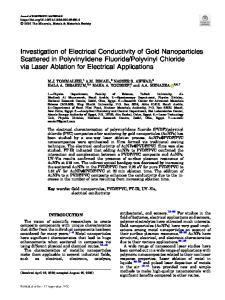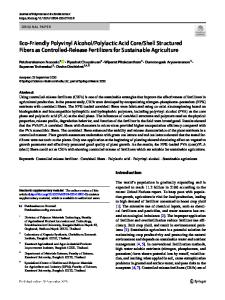Production of the ZnO-folic acid nanoparticles and poly(vinyl alcohol) nanocomposites: investigation of morphology, wett
- PDF / 3,824,461 Bytes
- 16 Pages / 595.276 x 790.866 pts Page_size
- 13 Downloads / 303 Views
ORIGINAL PAPER
Production of the ZnO-folic acid nanoparticles and poly(vinyl alcohol) nanocomposites: investigation of morphology, wettability, thermal, and antibacterial properties Shadpour Mallakpour 1 & Maryam Lormahdiabadi 1
# The Polymer Society, Taipei 2020
Abstract The packaging system is one of the most challenging researches, in which antibacterial agents were embedded. In this research activity, we used folic acid (FA), as a biosafe and biodegradable substance for the surface modification of zinc oxide nanoparticles (ZnO NPs). Then, the ZnO-FA NPs as nanofillers were inserted in the poly(vinyl alcohol) (PVA) with different weight percentages (2, 5, and 8 wt%, relative to polymer weight). The synthesized substances were characterized using various analyses like Ultraviolet-Visible (UV–Vis) spectroscopy, water contact angle, field emission scanning electron microscopy, and thermogravimetric analysis. The image of transmission electron microscopy analysis displayed the excellent dispersal of the ZnO-FA NPs within the polymeric matrix. By increasing the percentage of the modified ZnO NPs into the PVA, the intensity of the absorption peaks in the UV–Vis spectra was raised, and the thermal stability of NC films got better compared to the pure polymer. PVA/ZnO-FA NC film 8 wt% showed better antibacterial activity than the pure PVA and had the best resistance against Grampositive bacteria (Staphylococcus aureus). Keywords Antibacterial activity. Optical property. Sonochemical approach. Folic acid. Poly(vinyl alcohol)
Introduction Nowadays, one of the most important applications of the active packaging system is antibacterial packaging for food production. It is a system of packaging that can control the growth and inhibition of the activity of microorganisms, which can make food contamination. Some of the nanoparticles (NPs) have excellent antibacterial activity and can interact with the cell membrane of bacteria because of their high surface-ofvolume ratio. Hence, NPs have been recognized as nanofillers for making nanocomposite (NC) films to enhance their packaging performance [1, 2]. Electronic supplementary material The online version of this article (https://doi.org/10.1007/s10965-020-02200-7) contains supplementary material, which is available to authorized users. * Shadpour Mallakpour [email protected]; [email protected] 1
Organic Polymer Chemistry Research Laboratory, Department of Chemistry, Isfahan University of Technology, Isfahan 84156-83111, Islamic Republic of Iran
Among all of the polymers, poly(vinyl alcohol) (PVA) is introduced as a semi-crystalline polymer that has specific characteristics such as high chemical resistance, the capability to form the film, the good mechanical strength, solubility in hot and cold water, and biodegradability. This polymer has been widely considered in a variety of fields including textile, industry, adhesive, fuel cells, and so on. PVA contains a large number of OH functional groups that produce hydrogen bonding and can interact well with organic and inorgani
Data Loading...











